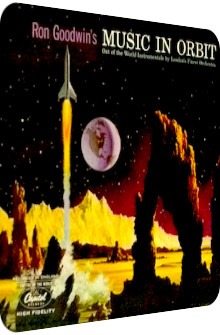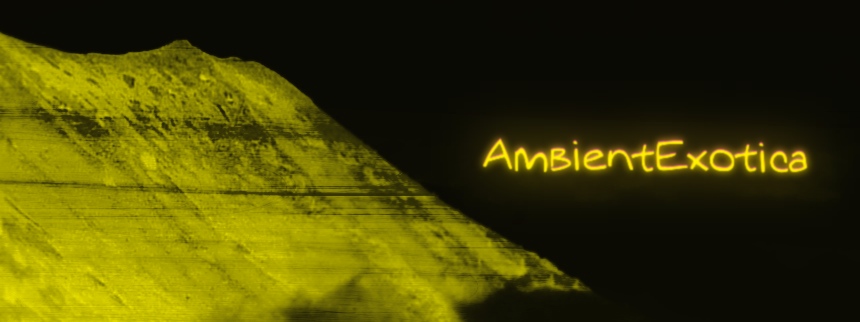
Ron Goodwin
Music In Orbit
1958
It is a privilege and honor that the multi-faceted amalgamation of various releases collected under the Space-Age label outshines the longevity of Exotica, if such a sentence even makes sense. Rest assured though that the essence is true: Space-Age as a genre – or alloy – is a force to reckon with and has, in a way, always been there, from Gottfried Huppertz’s score for Fritz Lang’s expressionistic movie Metropolis (1927) onwards. When the race to the moon leaves the people of the Western world breathless with excitement, the genre is already more than 30 years old and provides a variety of themes and arrangements, be they alienating, mysterious or technocratic. A surge of releases happens in the years of 1955 till 1959 and then again in 1968/69, unsurprisingly so. One of the greatest symphonic Space-Age albums is undoubtedly Music In Orbit by British composer and conductor Ron Goodwin (1925–2003).
Released in 1958 on Capitol Records, its 12 unique compositions literally shuttle around genres and tributaries that are all well considered, but not within the boundaries of one single record. Oscillating between standardized symphonies, flamboyant vignettes and twisted genre convulsions that even recall Al Caiola’s Music For Space Squirrels (1958) in one way or another, Ron Goodwin and his London Orchestra branch out into various directions, not all of them truly exciting, some of them even too bland and normal for a travelog, but the scattered obscure parts, colorful melodies and vertiginous heights make this a worthwhile effort that deserves a closer inspection of its weaknesses and triumphs.
Yes, it is true: all hopes for a crazy and over-the-top Space-Age lift-off are crushed right within the opener Departure, although its name promises excitement and adventures considering the encompassing topic. There’s nothing wrong with Goodwin’s depiction though: brass fanfares, whirling string, uplifting flutes and sharp cymbals altogether paint both a fibrillar and joyous prelude, with the only galactic texture being the punctilio of the xylophone. The great melodies, however, make the opener a superb joyride where Goodwin overcomes the omitted effects with the power of serration and hooks, a motif that reappears time and again over the course of this album. The Moon, for instance, is aglow with mauve-tinted supersets of strings that are much more romantic and simmering than cold and mysterious. A most transfiguring mélange and curious intermission as it exchanges excitement for contemplation.
It is Sally The Satellite which resurrects the uplifting vibes, and more so, transplants a mountainous hillbilly guitar into the harp-accentuated string fest. Suddenly, it’s ragtime, and no-one saw that coming. Well, except for the aforementioned Al Caiola. Uniting an energy this raw with the mellifluousness of symphonic veils is a feat that is only justifiable in Space-Age records. No cosmic interludes or dizzying tone sequences are evoked, but this synergy alone is colorful enough. Meanwhile, The Venus Waltz says it all in its title already: fountained string fibers pour into the interstices of the flute- and glockenspiel-accentuated realms, one is reminded of lachrymose travelogs such as Werner Müller’s Holiday In Italy (1956), and if Goodwin’s piece were to appear in a large and shuffled playlist, chances are that I’d mistake it for an Italian symphony.
The album gains bonus points soon enough though, or what else is there to say when a title such as Mercury Gets The Message materializes? Bona fide alto flutes tumble over a jazzy double bass rhythm that is only cautiously interpolated with sun-dappled guitars and galactic vibes. Ron Goodwin surprises yet again with a style-breaking iteration before The Sun finishes side A in a gorgeously exhilarative fanfare that is magnificently awash with powerfully good-natured strings and festive mallet instruments, gongs and flutes. It’s the source of life, our solar system’s lightbulb that is worshipped here in the possibly greatest piece of the album.
As if the orchestra wanted to shake off the vivacious majesty of The Sun, side B’s opener Jumping Jupiter turns out to be a cheeky turmoil of pluvial strings, harp interstices and hi-hat rhythms that are once more rightfully at home in light music instead of orchestral realms. Not particularly otherworldly, the piece is lively enough to enchant. Martians On Parade, however, is it: the greatest Space-Age gem of the album. Awfully cute – and pitched – vocals, military march surroundings, stacked flutes and scything dark matter horns impose a Bohemian twilight and trigger the right synapses, making this a wonderfully weird synergetic symphony to sing along with.
While The Milky Way allows a superb motionless gaze of awe and wonder via twinkling mallet instruments, solar-powered harps and minimalist segues of enigmatic strings and quiescence, The Rings Around Saturn is a marimba arrangement at its heart and rounds off the arpeggiated aorta with flute flumes, double bass backings and an all-male doo-doo Space-Age choir – what a delight! Afterwards, Playtime On Pluto shuttles between a clandestine photometry, ebullient cauldrons full of harps and stacked horn helixes before Return My Love tumbles back into earthbound spheres. Downwards-spiraling glitters, oneiric flutes, Honky Tonk pianos and auroral strings are multiplexed, leaving a smiling listener behind on Earth.
Admittedly, Music In Orbit starts in a lackluster fashion and seems too normal and common to truly depict its galactic material, but the first few missteps are more than elbowed away by the later pieces that are surprisingly progressive. Even though there is no theremin, ondioline, harpsichord or other alienating instrument on board, the gyration around euphonious and slightly discordant melodies as well as the powerful aura of said melodies themselves make Ron Goodwin’s only Space-Age album a force to reckon with. For every missed opportunity there is a sudden surprise, be it weird melodies, the inspired use of limited textures or the augmentation of a formerly symphonic piece with stylistic entities that can only be called foreign matter in view to this project.
All 12 pieces have their accessibility in common, meaning that they first and foremost want to enchant the listening subject, but once this realization settles, every alternation hits all the stronger, be it the semi-portentous march on Martians On Parade, the Ragtime interlude Sally The Satellite or the minimal marimba manifesto The Rings Around Saturn with its cautious – and almost hidden – use of the choir. Considering all these tendencies and motifs, Music In Orbit is a great Space-Age album. It lacks the pompous-immersive cinematography of Russ Garcia’s Fantastica and swinging technicolor kaleidoscope of Les Baxter’s Space Escapade (both 1958), but enthralls with powerful melodies and – could it be? – the greatest array of styles, genres and expectations. Music In Orbit is available on vinyl, CD and in digital music stores as well as streaming services.
Exotica Review 406: Ron Goodwin – Music In Orbit (1958). Originally published on Jan. 17, 2014 at AmbientExotica.com.
